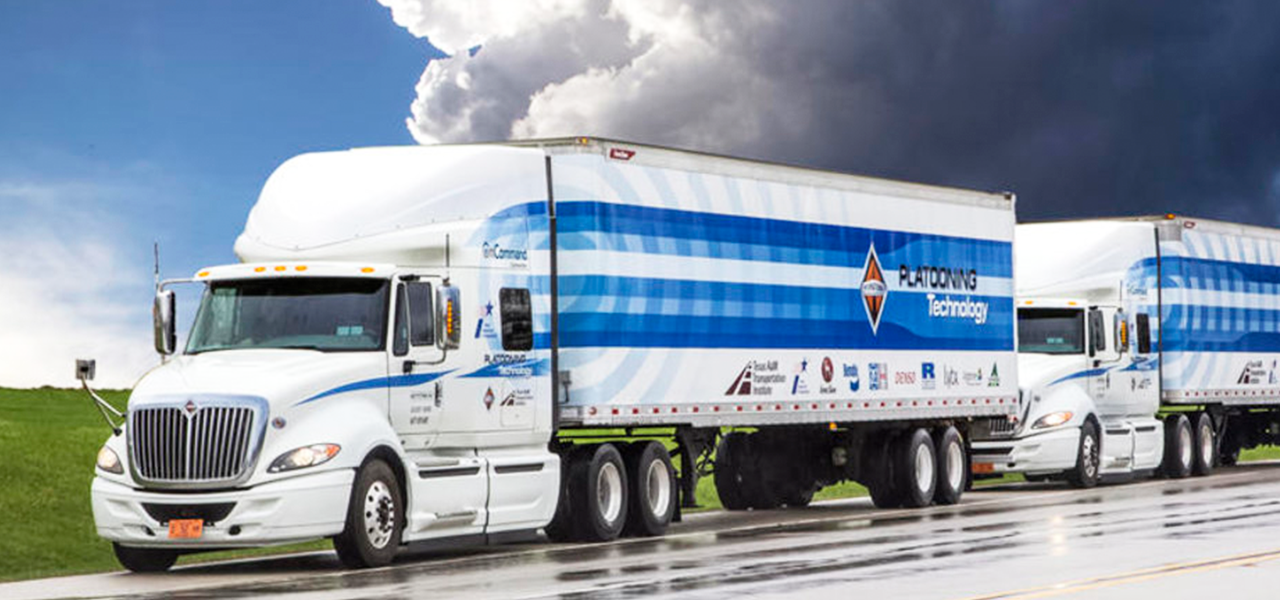 Has platooning finally arrived? Since the beginning of the 2010s, truck manufacturers have been working on a new generation of freight transport: trucks that follow one another meters apart, and are fitted with self-driving technology and real-time communications (Wi-Fi, GPS and radar). The lead out man and its band of automated followers form a peloton that is supervised from a control center. By synchronizing vehicles, braking and accelerating will be optimized, as well as the aerodynamics of a vehicle’s journey, ensuring road haulage is safer and more energy efficient. The first tests carried out by research labs in 2014 give a glimpse into the encouraging effects on energy consumption, with fuel economies of around 6 to 7% on average. While automated systems are designed to avoid collisions, security is proving to be the other biggest priority for manufacturers and authorities. Early figures show a 35 to 70% reduction in crashes and accident-inducing behavior on the road.
Has platooning finally arrived? Since the beginning of the 2010s, truck manufacturers have been working on a new generation of freight transport: trucks that follow one another meters apart, and are fitted with self-driving technology and real-time communications (Wi-Fi, GPS and radar). The lead out man and its band of automated followers form a peloton that is supervised from a control center. By synchronizing vehicles, braking and accelerating will be optimized, as well as the aerodynamics of a vehicle’s journey, ensuring road haulage is safer and more energy efficient. The first tests carried out by research labs in 2014 give a glimpse into the encouraging effects on energy consumption, with fuel economies of around 6 to 7% on average. While automated systems are designed to avoid collisions, security is proving to be the other biggest priority for manufacturers and authorities. Early figures show a 35 to 70% reduction in crashes and accident-inducing behavior on the road.
According to an EU roadmap on the topic, technological progress in the years to come, standardization (including multi-brand platooning) and updating road infrastructures should make platooning a reality on Europe’s roads come 2023 – providing no specific authorizations are required.
Automobile and truck manufacturers joining forces together as consortiums like “EcoTwin” (made up of the manufacturers DAF Trucks, TNO, NXP and Ricardo), are looking to make the technology on a large scale by 2020. In America, the first tests on public roads were authorized during 2017, and are to be rolled out in about a dozen states by the manufactures Daimler, Navistar and Volkswagen. Not only that, technology (Intel, Nokia, Lockheed Martin) and energy (BP) giants are also investing in platooning.
Legislations allowing a fully automated driverless fleet to drive without any human intervention may, however, have to wait for now. Although, it is this level of autonomy that justifies the rather hefty investments made, just look at the $700 million Uber paid to purchase the startup Otto, for example. In the meantime, other new arrivals on the scene are attempting to win the technology race. Take the Californian company Peloton Technology, who, back in mid-2017, raised a considerable amount of funding, and announced they would be launching commercially in 2018 or even 2019. Even if they do need rather ambitious goals in order to attract investors, the numerous newcomers on the emerging platooning market aren’t necessarily talking about full autonomy. Peloton Technology assures that the vehicle-to-vehicle (V2V) communications system they use in their fleets does not eliminate human control of any vehicle.
There is, however, another friction point: the American National Academy of Sciences (who expects platooning to be one of the first applications for autonomous vehicles) raised a rather valid question concerning infrastructures. As freight trucks cover the same route in succession, this could result in speeding up damage caused to roads. However, research into the potential impacts has yet to be made, but if the results were corroborative, a global reevaluation of the state of roads and infrastructures would be necessary, especially for bridges (in America, around 60,000 bridges are deemed structurally deficient). However, competition between states (who receive an economic incentive for allowing platooning on their roads) could simply accelerate the dynamic. Rolling out V2V technology to trucks was something the Obama administration wanted to do – and still remains to be killed off by his successor.
